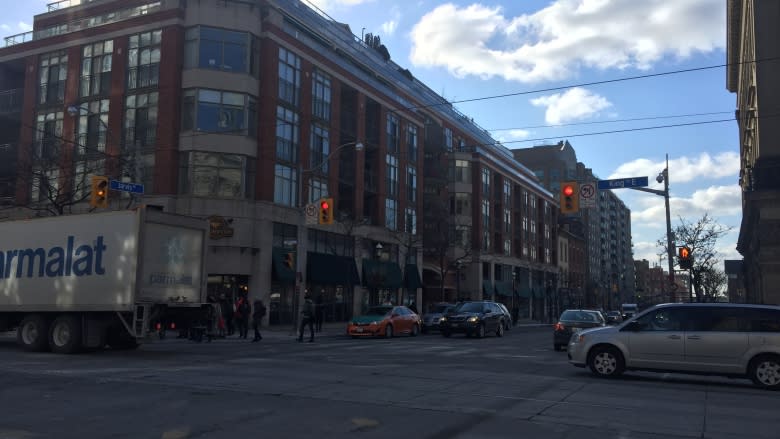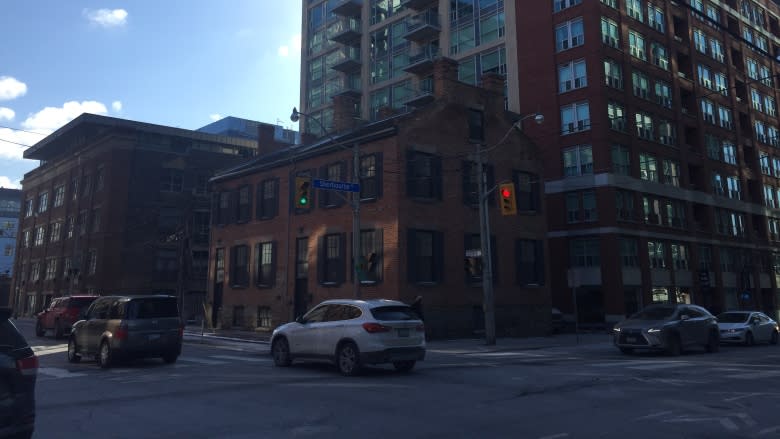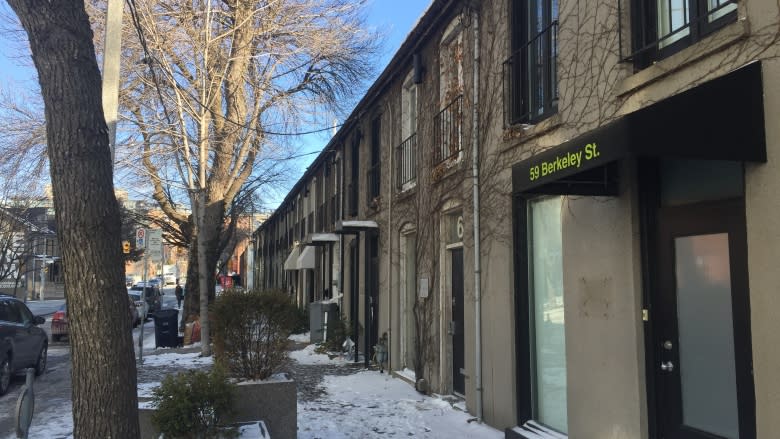Revealing downtown Toronto's Irish roots, one hidden house at a time
Sandwiched between condos, hidden on side streets and lurking under pavement, Toronto's history of Irish immigration can be hard to see at first glance.
Jared Ross, who works for Mackenzie House under the City of Toronto's museums and heritage services department, has made it his business to discover the remaining landmarks and put them together in a walking tour, which he will lead on Saturday.
Localized in Corktown and Cabbagetown, the Irish immigrants who came to Toronto in the 1800s built houses and businesses, creating a vibrant community with its own churches and newspapers.
Though many of those buildings were torn down or burned, Ross gave CBC Toronto a sneak peek of places where it's still possible to glimpse history.
1. Statue honouring potato famine victims in front of St. Paul's Basilica, 83 Power St.
St. Paul's Basilica, the oldest Roman Catholic congregation in Toronto, was also "one of the first stopping points" for Irish immigrants who needed aid after coming to Canada following the potato crop failure and famine in Ireland, said Ross.
Some 40,000 Irish immigrants passed through Toronto in 1848, which at the time had just 20,000 residents, he explained.
Victims of the famine — many of them the families and communities of those who came to Canada — are honoured on a monument alongside Bishop Michael Power, who saw the famine breaking out in Europe and "realized there was going to be a wave of refugees" in Canada, according to Ross.
Power began raising money, Ross said. "He was also ministering to people coming off boats that were quite sick with typhus, or as it was known, ship's fever. He contracted the ship's fever and died, so he's commemorated on the monument to the victims of the famine because in a way he was one as well."
2. Former graveyard behind St. Paul's Basilica
Now a schoolyard, the area behind the Basilica was once a graveyard in which many Irish immigrants who arrived in Canada with typhus were buried.
Immigrants would arrive by boat at Front and Bathurst streets, in the area now called Ireland Park, said Ross. They were often quarantined at "fever sheds", located close to the intersection of King and John streets.
If they died, "there were hearses drawn along King... and they would be interred here," said Ross.
Though many graves were moved, a renovation at the school prompted the discovery of more burial sites.
"So there are still some remains in the area," he said.
3. Intersection of King and Jarvis streets, site of 1858 St. Patrick's Day riot
This intersection was the approximate site of a bloody riot when tensions between Catholics and Protestants in Toronto exploded on St. Patrick's Day in 1858, said Ross.
"[Irish Catholics] usually paraded on St. Patrick's Day down King Street. The Orange Order, which was a Protestant group, were not big fans of this," he explained.
"An Orange driver, we suspect, drove his cart to block the march. There was a melee that ensued," said Ross, which left an Irish Catholic man stabbed and killed.
"It was one of the bloodiest riots in Toronto history."
4. Paul Bishop's House, 363-365 Adelaide St.
Built in 1842 by a French-Canadian blacksmith, Paul Bishop's House on Adelaide Street was part of an Irish area with a sordid reputation.
"Kind of known as a no-go area, [with] slums and houses of ill-repute," said Ross.
Though the reputation of the area was "infamous," Ross said that not all of the talk was warranted.
"George Brown, he was not a big fan of Irish-Catholic immigration to Toronto. He used his newspaper, The Globe, to attack these immigrants and talk about crime and how dangerous these neighbourhoods were," he explained.
5. Adelaide and Berkeley streets, site of Irish tenements
Home ownership was as important to Irish immigrants in the 1800's as it is to Torontonians today, explained Ross.
Irish tenements were built around the intersection of Adelaide and Berkeley streets, but were largely used as a temporary stepping stone towards building a home of one's own.
"There were charities that enabled people to actually build their own homes, and you could buy your house in installments," he said.
Unlike cities like New York, said Ross, relatively few people stayed in smaller tenements for their lifetime.
The houses still standing on Berkeley were built after the immigration boom to Toronto in the mid-19th century, but Ross said they at least partially reflect the character of the street when it was still an Irish area.







